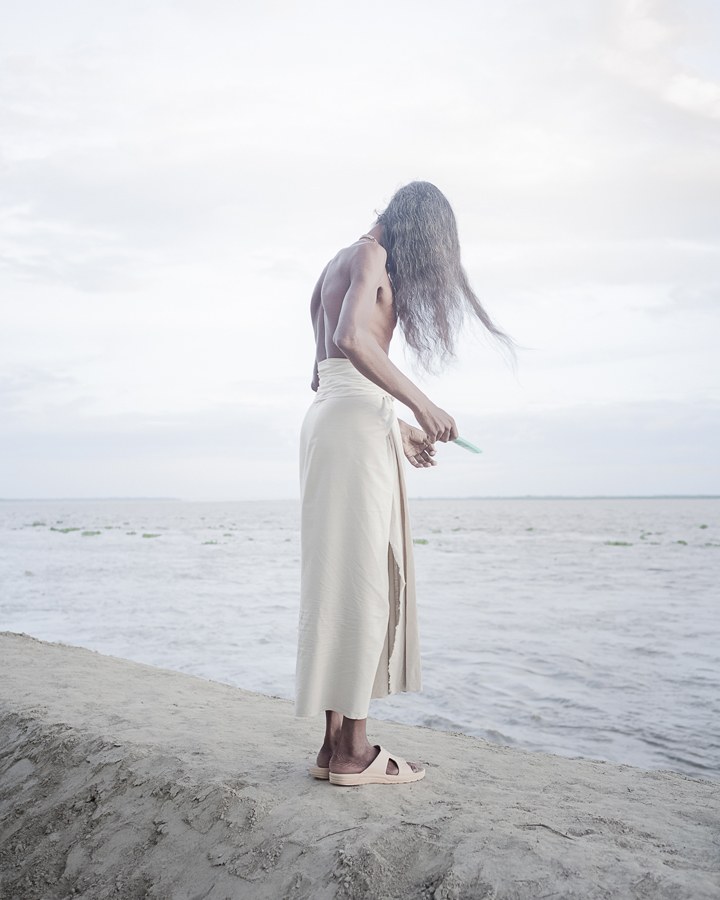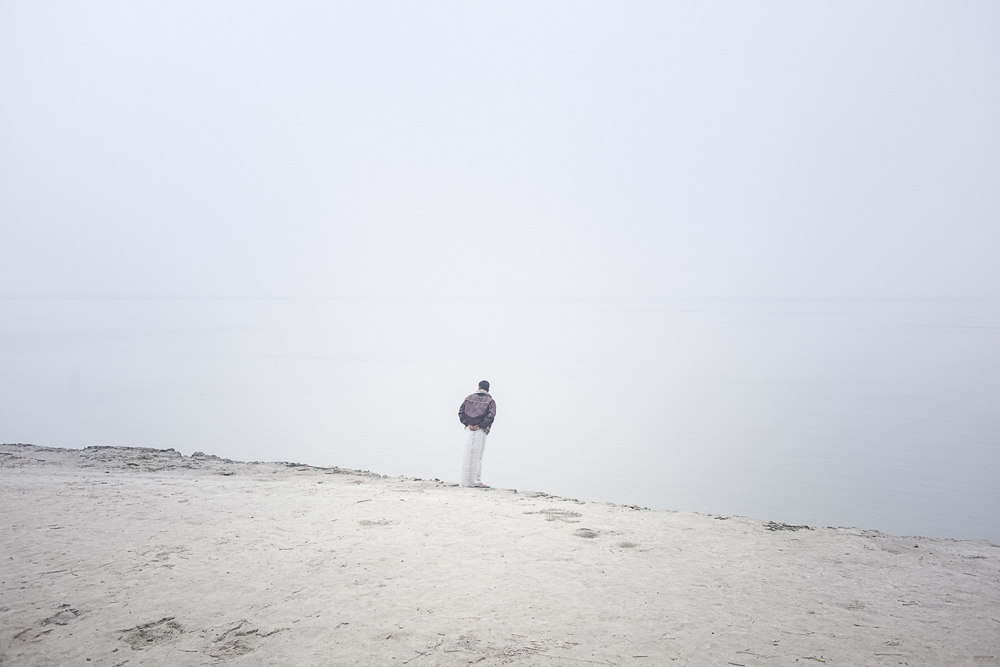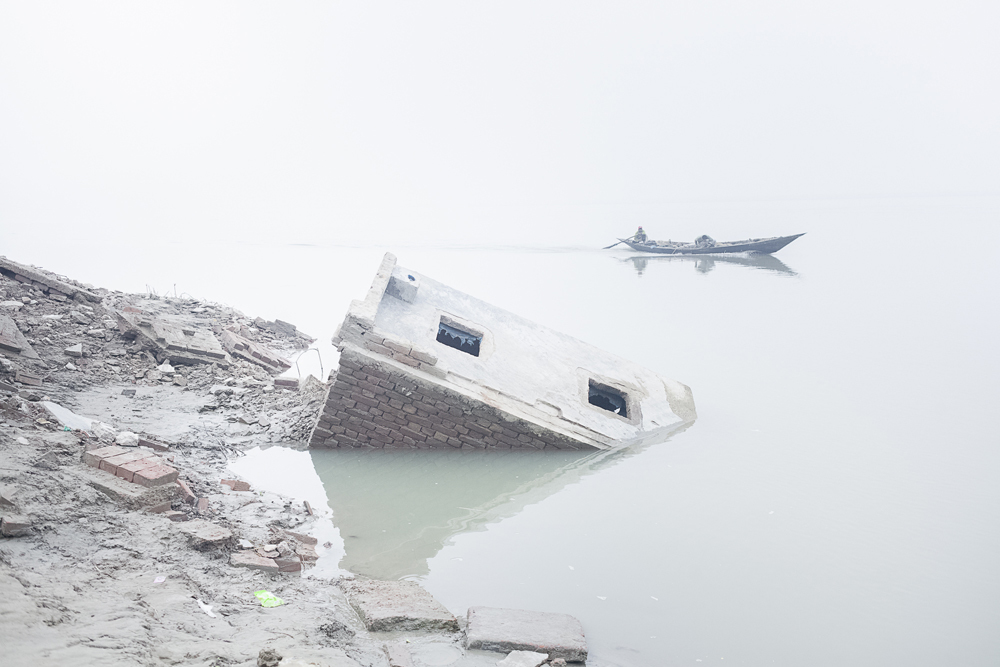Protick Sarker’s photographs dissect the relationship between Bangladeshis and the rivers that surround them
Through his melancholic photo series Of Rivers and Lost Lands, Bangladeshi photographer Protick Sarker portrays the complex relationship between nature and human beings that is both intimate and ruthless.
Growing up in Dhaka in the early 90s, Protick Sarker’s tryst with photography began with a lo-fi camera on his first ever cell phone. Seven years down the line, his extensive photo projects have trotted the globe through exhibitions like Chobi Mela, Paris Photo, Hamburg Triennale of Photography, and most recently Singapore Art Week.
In Of Rivers and Lost Lands, a looming fog envelopes the Padma river that sustains livelihoods and at times, washes everything away. As monsoon rolls in every year, lands are lost to the gushing water. By turning his focus on the people that inhabit these ever-shifting banks, Protick deconstructs the connection between these humans and their environment. His haunting images hint at his dexterous sense of colours, light and composition, which in turn shape his distinct aesthetic.
He connects with us from his studio in Dhaka and takes us through his atmospheric photo series and experiences that influenced his craft.
Let’s trace back to the very beginning of your career. You were studying business management and then moved into the realm of photography, what spurred this shift?
I had my first brush with photography when I bought a Toshibamobile phone. I remember being fascinated by the black and white filter in the camera; I had never seen or used something like this before. I started shooting portraits of my friends when we’d hang out, and at night, I’d be out in the city making images of the streets of Dhaka post sundown. After seeing a few of these images, an uncle of mine suggested I take up a course in photography at Pathshala South Asian Media Institute. So every day after finishing business school, I’d head to Pathshala to attend evening classes. This is where I learnt about the history of photography and especially, the evolution of Bangladeshi photography.
During my final year in Pathshala, the school published a retrospective book titled Under The Banyan Tree that looked back at 12 years of the academy. I was selected as one of the 15 photographers whose work was showcased and my images appeared alongside the works of Abir Abdullah, Munem Wasif and Jannatul Mawa. That was the moment when the fact hit home that this was what I wanted to do, and maybe, I was talented enough to pursue it as a vocation.
What drew you to the banks of the Padma river in 2011 and inspired Of Rivers and Lost Lands?
I enjoy being around water, and have always been fascinated by nature. When you go to school in my country, one of the first things you learn is that Bangladesh is a riverine nation. The entire landscape is sculpted by numerous rivers and its history, culture, literature, music and food is strongly influenced by the water that surrounds us. My interest in the Padma river began when as a child, I’d visit my grandfather’s house which stood close to the banks of the river in a district called Ishwardeep. This is where I first witnessed river erosion and the havoc it can cause at times. Padma is the protagonist in this narrative; the land and its people slowly come into view through the series and find their place in the story. The river gives so much to its people and at times it takes away everything. When the monsoon arrives and the river runs fast, the lands are washed away. Most of the places seen in these photographs do not exist any more. As a result, these images survive as visual documents of these vanished lands.
You shot this project over seven years. You must have seen the relationship between the river, the land and its people shift through this time.
Yes, that relationship is like a living organism that shape-shifts a little every day. This project wasn’t focused on river erosion, yet somehow that became an integral part of the story I was telling. I have witnessed entire villages disappearing alongside new lands rising out of the river bed. As the river changes its course every monsoon, these islands - called chor in Bengali - rise from the belly of the river. There is something poetic about it; it’s almost like the river is trying to give back a little bit of what it has taken away. These grassy lands are turning into villages now, and I met a group of farmers who are now growing peanuts on these islands. I wanted to document this cyclical, and powerful shift between destruction and creation.
These images are melancholic, with desaturated colours. Was this visual treatment a conscious decision?
Absolutely. I would visit Ishwardeep during monsoon and winter, and would shoot only at the break of dawn or at dusk. The timing was incredibly important to achieve this visual tone, the flavour of light and the muted colour palette. A bright, sunny day would have made the same colours look flashy, which would have failed to conjure this mood of loss and melancholia.
The notions of death, disappearance and the slow yet unstoppable passage of time stand the crux of your body of work, especially in your project What Remains. What about these themes intrigue you the most?
Unpredictable loss was an ever-present part of my life, so I began gravitating towards these ideas early on. I lost my father, best friend and a very dear uncle quite unexpectedly. Documenting death and disappearance helped me cope with my feelings. In What Remains, I tried to capture the effect time had on my grandparents. When they were struggling with cancer and old age, I began making some images of their journey as an excuse to spend more time together because they were housebound in Dhaka due to their ailments. What began as an exploration of these themes has since flavoured all my projects that revolve around decay and the inevitable destruction of everything around us.
How would you define your approach to photography?
I have a bipolar approach to photography. A lot of people recognise my work through the long-term, thematic photo projects that I work on. These series call for in-depth research, planning and immense patience; some are executed over a span of four to five years. On the flip side, I also make images quite obsessively, shooting anything that catches my eye. These photographs are spontaneous and don’t necessarily follow a storyline. A chunk of photographs I clicked on my mobile phone ended up in Astres Noirs, my debut photo book made along with photographer Katrin Koenning. This impulsive and almost fixated way of documenting my daily life fuels my photographic practice.
Talking about this daily ritual of obsessive image making, what kind of stories or ideas were you capturing then?
When I first started making these daily images, I only captured light. Light is amorphous and intangible. What happens when you look at light as an independent element? You cannot hold it, or possess it; I wanted to capture the forms it creates while moving through sieves, shafts or other mediums like water. Lumiere was a collection of images through which I explored the effects of light and the textures, patterns and geometrical shapes that are born of it.
What has been your biggest learning from your life behind the lens?
I’ve learnt to be more patient to tell the right stories when they need to be told. As a young artist, I was quite impulsive so I channeled that into the dichotomy of my practice. My biggest learning as a photographer has nothing to do with the craft itself. Instead, I want to use the art to bring the world’s dire situation to light. We really need to think about how our actions are impacting nature that sustains us. It might already be too late, but I’m determined to do my bit and garner some awareness through my work for as long as I’m here.
What are you currently working on?
This year, the Bangladeshi government declared their plans to chop down all the trees that line the famous Jessore Road. Jessore Road stretches through Calcutta in India, to Bangladesh. During the Partition of Bengal, scores of refugees migrated from the then West Pakistan to India and vice versa using this stretch of road, so it has a huge historical and cultural value. Each of these trees that the government is planning to cut down are at least a century old. They have stood the test of time, like silent chroniclers of history. The government’s plan is currently on hold, but I am planning on shooting a photo series centred around these trees. I was inspired by the song Jessore Road by Calcutta-based musician Moushumi Bhoumick as well as the poem, September on Jessore Road written by Allen Ginsberg. Much like Padma in Of Rivers and Lost Lands, the trees will be the protagonist of this story.














